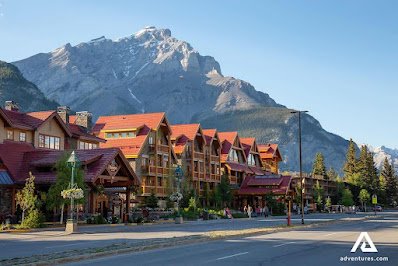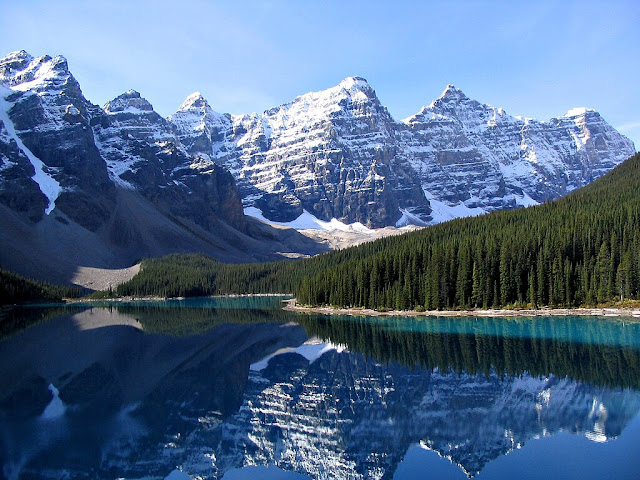![]() Canada's National Parks have their origins in the establishment of the Rocky Mountains Park (now known as Banff National Park) in 1885. It was the first national park in Canada and the third in the world, following Yellowstone in the United States and Royal National Park in Australia.
Canada's National Parks have their origins in the establishment of the Rocky Mountains Park (now known as Banff National Park) in 1885. It was the first national park in Canada and the third in the world, following Yellowstone in the United States and Royal National Park in Australia.
The creation of Banff National Park was driven by the Canadian Pacific Railway (CPR), a transcontinental railway company. The CPR recognized the tourism potential of the scenic Rocky Mountains and sought to attract visitors to its rail line. The Canadian government, under Prime Minister Sir John A. Macdonald, supported the idea and saw it as an opportunity to promote Canada's natural beauty and stimulate economic growth.
Banff National Park was initially established as a small reserve surrounding the hot springs in the Banff area. Over time, it expanded to include more land and became a full-fledged national park. The government appointed a park superintendent to manage the park and ensure its protection.
The success of Banff National Park led to the establishment of other national parks across Canada. In 1895, the second national park, Yoho National Park, was created in British Columbia. Other parks followed, including Glacier National Park (now part of Rogers Pass National Historic Site), Jasper National Park, and Waterton Lakes National Park.
The process of building and developing these national parks involved various stakeholders, including government officials, park administrators, and Indigenous communities. Infrastructure such as roads, trails, visitor centres, and accommodations were constructed to facilitate access and enjoyment of the parks.
Today, Parks Canada, an agency of the Canadian government, manages and oversees the national parks system. The agency is responsible for preserving and protecting the natural and cultural heritage of these parks while providing opportunities for visitors to experience and appreciate Canada's diverse landscapes and ecosystems.
It's important to acknowledge that the establishment of Canada's National Parks occurred on the traditional territories of Indigenous peoples. Indigenous communities have long-standing connections to these lands and continue to play important roles in the stewardship and management of the parks. Efforts are ongoing to collaborate with Indigenous communities and incorporate traditional knowledge and practices into park management and decision-making processes.

The townsites within Canada's National Parks were primarily developed by the Canadian government and various private entities. These townsites were created to provide infrastructure and services for visitors to the parks, as well as for the local communities living within or near the park boundaries. The development of townsites aimed to support tourism, facilitate access, and enhance the overall visitor experience.
In the case of Banff National Park, the townsite of Banff was established as a result of the growing popularity of the park and the need for amenities and accommodations. The Canadian Pacific Railway played a significant role in the development of Banff as a tourism destination. The railway company built the Banff Springs Hotel, which opened in 1888, attracting wealthy tourists and serving as a catalyst for further development.
Similarly, the townsite of Jasper within Jasper National Park was established to support tourism and accommodate visitors. The Grand Trunk Pacific Railway, later known as Canadian National Railways (CNR), played a prominent role in the development of Jasper as a tourism hub. CNR built the Jasper Park Lodge in 1922, contributing to the growth of the townsite.
Other townsites within Canada's National Parks, such as Field in Yoho National Park and Waterton Park in Waterton Lakes National Park, were also established to cater to tourists and provide necessary services and accommodations.
The townsites within the parks were developed through a combination of public and private investments. The Canadian government and park management agencies worked in collaboration with private businesses and local communities to plan and construct the necessary infrastructure, including roads, hotels, campgrounds, visitor centers, and other amenities.
Over the years, the townsites have evolved and expanded to meet the needs of growing visitor numbers while aiming to maintain the ecological integrity and natural beauty of the surrounding park environments. Today, these townsites within Canada's National Parks continue to serve as gateways for visitors and offer various services, accommodations, and recreational opportunities.
There is no truth to the rumor that townsites within Canada's National Parks were built by prisoners. The development of townsites in the national parks was primarily driven by the Canadian government, railway companies, and private entities, with the aim of supporting tourism and providing services for visitors.
While it is true that some national parks in different countries have historical connections to prison labor, this is not the case for the townsites within Canada's National Parks. The townsites were established to promote tourism, facilitate access, and enhance the visitor experience in these natural areas.
The development of the townsites involved a combination of public and private investments, including the construction of infrastructure such as roads, hotels, visitor centers, and other amenities. These efforts were undertaken by various entities and stakeholders, working together to accommodate the growing number of visitors and promote the parks as destinations.
It's important to rely on accurate information from reliable sources when discussing the historical development of townsites within Canada's National Parks, as rumors and misinformation can sometimes circulate.
Source: Some or all of the content was generated using an AI language model


No comments:
Post a Comment